Colorado Elk Seasons
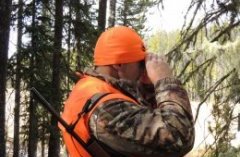
Gearing Up For Elk Season (Clothing and Equipment)
Colorado’s rugged terrain and unpredictable weather can challenge even the most experienced big-game hunter. Therefore, it’s important to have the proper clothing and equipment before heading out into the backcountry. For a new hunter, the endless choices of clothing and hunting gear can be overwhelming. Thankfully, this article will help you sift through the endless clutter.
Here are a few of the primary items that you’ll need to help make your elk hunt safe, comfortable and as successful as possible this season:
Clothing
If you’ve never hunted Colorado’s high country, there are three basic elements in selecting clothing: layers, weight and fabrics.
1. Layers
The first rule of selecting attire when big-game hunting is dressing in layers. Because Colorado’s weather can change rapidly, dressing in several layers allows you to easily adapt to the current conditions.
For example, instead of wearing one heavily insulated parka, consider packing the combination of a fleece jacket with a lightweight, waterproof rain jacket. Now your insulation and waterproof layers can be mixed and matched separately for varying weather and conditions.
Here’s an example of a layering system for an early season hunt:
Base Layer: underwear, T-shirt and long underwear (top and bottom)
Mid Layer: long-sleeve shirt, pants
Insulating Layer: Fleece or down jacket and vest
Outer-Shell Layer: Lightweight rain jacket and rain pants
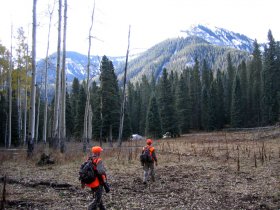 2. Weight
2. Weight
It is important to ensure the weight of your clothing is realistic for hiking around at altitude. In fact, this goes for all of your gear. Bulky clothing and equipment is certainly not a problem when walking a couple hundred yards to your tree stand when whitetail hunting. But when hiking potential miles at high altitude, it will wear you down quickly.
Most manufacturers these days produce clothing that has high warmth to weight ratio. Unless you’re not straying far from base camp, sell off your old, heavy clothing and replace it with newer, lightweight garments.
3. Fabrics
When selecting clothing for your hunt, we recommend high-tech, synthetic fabrics or merino wool. Nothing is heavier or more uncomfortable than a wet pair of jeans, and cotton quickly loses its thermal properties when wet.
For base layers and insulating layers, synthetics like Capeline or polypropylene are ideal. Merino wool is also a good choice. They wick moisture away from your body, dry fast and have good insulating properties.
Many companies produce this type of clothing and it can be found at very reasonable prices. Think twice before spending a fortune on clothing with silver or carbon scent-control. An elk standing downwind won’t appreciate that your clothing is silver-laced. Worry more about investing in top-of-the-line outerwear, boots and optics.
In outerwear, you truly get what you pay for. High-quality outerwear will be able to stand up to the elements, while still being breathable, lightweight and packable.
Gore-Tex, eVent or a similar 3-layer fabric is recommended for rain gear. The 3-layer membrane systems offer the best combination of weather resistance and breathability. For early season hunts, Gore-Tex PacLite is an excellent material, offering great protection in a very lightweight package.
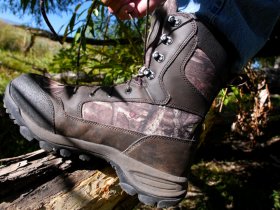 Next, look for outerwear with pit zips, as this will further increase breathability. When climbing up a steep slope, the last thing you want is nonbreathing rain gear that makes you wet and clammy from the inside.
Next, look for outerwear with pit zips, as this will further increase breathability. When climbing up a steep slope, the last thing you want is nonbreathing rain gear that makes you wet and clammy from the inside.
Ultralight rain gear is a very popular choice these days. These are usually made up of a 2-layer system: a nylon-type fabric with a laminate coating to repel water. While they usually weigh only a few ounces and pack to the size of a coffee mug, these Ultralight garments will not stand up to heavy abuse and lose their water repellency in a relatively short time. They must be “rewaterproofed” each season.
While a Gore-Tex type material can cost twice as much as some alternatives, I’ve found it will last much longer. I recommend purchasing quality outerwear upfront and having rain gear that will last you for years to come.
Footwear
Footwear is another area where you don’t want to skimp. Elk hunting will put some serious miles under your feet. Boots are one of the most important pieces of gear you will purchase.
We recommend buying the best Gore-Tex boots you can afford. They should be comfortable, reasonable in weight and offer good traction for hiking. Also, it is very important to get out and hike in them a few times prior to your hunt. Most new boots today don’t require much break-in time, but the last thing you need is to start your hunt with new boots that result in blisters on your feet.
When it comes to socks, merino wool is now the standard. It helps control moisture and temperature. Many companies, like Smartwool, offer merino wool socks in a variety of weights and cuts.
Other Gear
Any Western big-game hunt will require a quality backpack that fits you well. Consider something with about 1800-2000 cubic inches of space and a decent selection of pockets. This should offer plenty of space for your extra gear, water and clothing. If you think you need a larger pack, you may be trying to carry too much.
Another item to consider is quality optics. Again we’d recommend the best that you can afford. For hunting in Colorado, 10x or 8x binoculars are recommended. One of the most popular choices is 10×42.
Next, you will need a good headlamp and flashlight. If hunting with horses, consider a headlamp that offers a red lamp too; red lighting will not spook horses like white light sometimes does. Headlamps can be found relatively inexpensively. As long as it fits in your pocket, it will do just fine.
Finally, we’d recommend a water purification bottle—the type you can fill from a stream or lake and it purifies the water as you drink. Most areas will have access to water, so this can significantly cut the weight you need to carry on your back as opposed to carrying bottled water.
You might also like
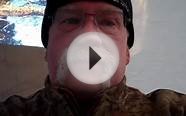
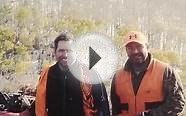
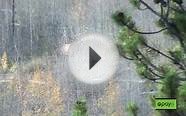
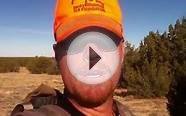
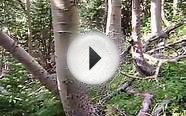
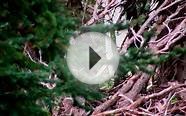
|
New Seasons for Deer and Elk / The 700-Yard Sportsman / Bighorn Rescue / The Chalk Cliffs State Trout Rearing Unit / Flash Flood Fish / Guide to State & Wildlife Fishing Areas (Colorado Outdoors, Volume 26, Number 2, March-April, 1977) Book (Colorado Division of Wildlife) |
|
|
The Hassle Over License Fees / The 1976 Deer and Elk Season / Middle Taylor Creek / North Park's Sage Grouse / Fishing Colorado's Little Rivers (Colorado Outdoors, Volume 25, Number 5, September-October, 1976) Book (Colorado Division of Wildlife) |




